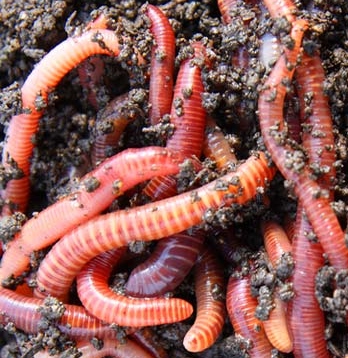Red wigglers: For organic gardening
Red wigglers: For organic gardening
Blog Article
Every Little Thing You Required to Understand About Red Wigglers for Composting
Red wigglers, or Eisenia fetida, play a critical function in the world of composting, changing natural waste right into beneficial dirt modifications. Their unique biological characteristics enable them to flourish in different conditions, making them an optimal selection for both amateur and seasoned composters alike. Recognizing their requirements and benefits is crucial for establishing a productive vermicomposting system. The process of setting up a worm bin and maintaining it can posture obstacles. To effectively harness the possibility of these worms, one have to discover the ins and outs of their care and administration.
What Are Red Wigglers?

(red wiggler earthworms for sale)
Native to The United States and copyright, red wigglers are surface-dwelling microorganisms that favor wet, cozy environments rich in breaking down natural issue. Their diet regimen is composed mostly of rotting plant material, food scraps, and other natural particles, which they take in and break down efficiently. As they absorb this product, they create nutrient-rich castings that enhance dirt fertility.
Red wigglers are hermaphroditic, having both male and female reproductive body organs, and can recreate promptly under optimal conditions. On the whole, red wigglers are vital factors to the procedure of recycling organic waste right into beneficial compost.
Benefits of Making Use Of Red Wigglers
Utilizing red wigglers in composting systems supplies numerous advantages that improve both the performance of waste management and the high quality of the resulting garden compost. These worms, scientifically called Eisenia fetida, are especially reliable at damaging down raw material, turning kitchen area scraps and backyard waste right into nutrient-rich compost at an accelerated price.
Among the key advantages of using red wigglers is their ability to take in big amounts of natural product, often processing their weight in food waste daily. This high consumption rate causes quicker disintegration and lowers the quantity of waste sent out to land fills. Furthermore, the castings produced by red wigglers are rich in important nutrients, useful bacteria, and enzymes, making them an exceptional plant food for yards and plants.
Additionally, red wigglers flourish in a range of atmospheres, making them adaptable for both interior and exterior composting systems - red wigglers. Their visibility in a garden compost bin helps to aerate the product, stopping odors and promoting a healthy composting process. Overall, using red wigglers not just contributes to effective waste management yet likewise supports lasting horticulture methods through the manufacturing of top notch compost
(Hickory)
Setting Up Your Worm Bin
To efficiently establish up a worm container, it is necessary to select an ideal container that fulfills the needs of red wigglers while offering a favorable atmosphere for composting. An ideal container can be made from plastic, timber, or steel, with an ability of a minimum of 1 square foot for every pound of worms.
Ensure the container has adequate drainage openings to avoid excess moisture, as red wigglers prosper in a damp, however not waterlogged, atmosphere. red wigglers. The container should likewise be ventilated to provide adequate air movement, stopping anaerobic problems that could damage the worms
A perfect place for the worm container is a cool, dark location, without straight sunlight and extreme temperatures, as red wigglers favor a temperature array of 55 to 77 levels Fahrenheit.
Before presenting the worms, prepare bed linen materials such as shredded newspaper, cardboard, or coconut coir, which will provide both environment and food. Dampen the bed linen lightly to develop an inviting atmosphere for the worms. Consider positioning a cover on the bin to keep moisture and reduce parasites, while guaranteeing it can be easily gotten rid of for upkeep.
Feeding and Treatment Guidelines
Feeding red wigglers is a crucial element of keeping a healthy and balanced composting system. These worms grow on a varied diet plan, primarily made up of organic products such as vegetables and fruit scraps, coffee premises, and crushed eggshells. It is vital to stay clear of feeding them meat, dairy products, and oily foods, as these can develop undesirable odors and draw in pests.
When presenting food to your worm bin, slice or shred materials into smaller sized pieces to promote quicker decay. Start with little quantities to evaluate the worms' intake rate, slowly increasing the amount as they adjust. It is a good idea to alternative feeding places within the container to encourage complete mixing and aeration of the garden compost.

Troubleshooting Common Issues
Preserving a flourishing worm composting system can in some cases present challenges that call for focus and troubleshooting. Usual problems include an unpleasant smell, which usually shows overfeeding or the existence of anaerobic conditions. To remedy this, reduce the amount of food included and guarantee proper oygenation by blending the bedding product.
An additional regular problem is the retreat of worms from the bin. This can occur as a result of extreme wetness or unsuitable ecological conditions. Regularly examine the wetness levels, going for a moist but not soaked consistency, and maintain optimum temperatures in between 60-80 ° F(15-27 ° C )to produce a comfortable environment for your red wigglers.
Pests, such as fruit flies, can additionally get into worm containers. red wigglers. To fight this, cover food scraps with a layer of bed linens or shredded paper to prevent flies from laying eggs. Additionally, make certain that any food included is fresh and without mold and mildew, which can attract unwanted parasites
Last but not least, if your worms appear non-active, look for stress and anxiety aspects such as temperature changes or poor moisture. Resolving these common problems will certainly assist keep a healthy and efficient worm composting system.
Conclusion
In summary, red wigglers, or Eisenia fetida, play a vital role in sustainable waste administration with vermicomposting. Appropriate configuration and maintenance of a worm container, along with adherence to feeding standards, make sure a successful ecological community that decreases landfill payments.
Report this page